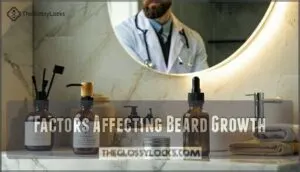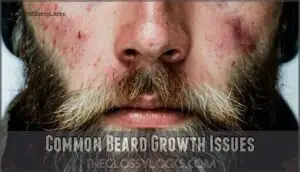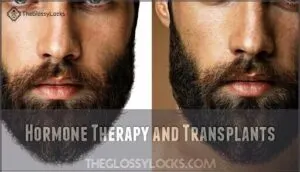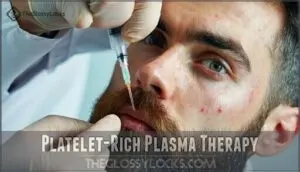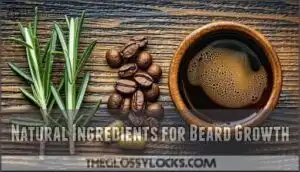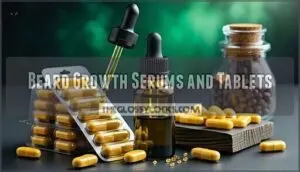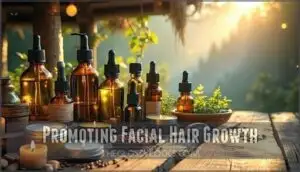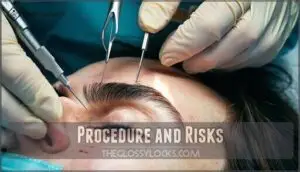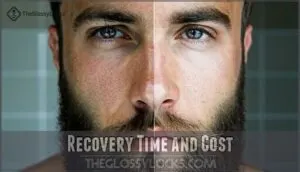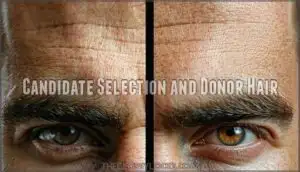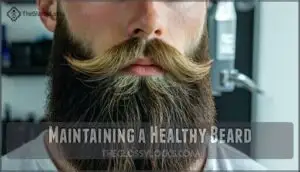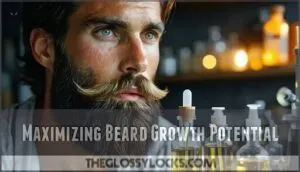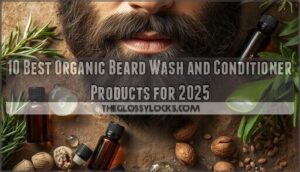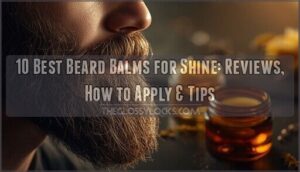This site is supported by our readers. We may earn a commission, at no cost to you, if you purchase through links.
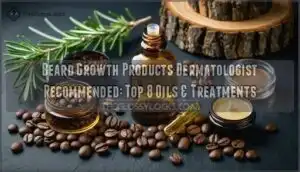
This FDA-approved treatment stimulates blood flow to hair follicles, encouraging growth where your beard feels patchy or thin.
You’ll also find dermatologists suggesting biotin supplements, which support healthy hair development from within.
Quality beard oils containing rosemary extract can boost circulation naturally, while caffeine-infused serums work like an espresso shot for sleepy follicles.
Don’t overlook platelet-rich plasma therapy for stubborn areas that won’t cooperate.
The secret lies in understanding which ingredients actually work versus marketing hype, and how combining different approaches creates your personalized growth strategy.
Table Of Contents
- Key Takeaways
- Factors Affecting Beard Growth
- Common Beard Growth Issues
- Medical Treatments for Beard Growth
- Top 8 Dermatologist Recommended Beard Oils
- Natural Ingredients for Beard Growth
- Beard Growth Serums and Tablets
- Promoting Facial Hair Growth
- Beard Transplant Surgery
- Maintaining a Healthy Beard
- Maximizing Beard Growth Potential
- Frequently Asked Questions (FAQs)
- What can a dermatologist do for beard growth?
- What is the 3 month beard rule?
- Does anything actually help beard growth?
- What is the rule 5 for beards?
- Can diet supplements accelerate beard growth timeline?
- Do beard growth vitamins actually work effectively?
- How long before seeing noticeable beard improvements?
- Are there any serious side effects risks?
- Can women safely use beard growth products?
- Conclusion
Key Takeaways
- You’ll get the best results with minoxidil – This FDA-approved treatment tops dermatologists’ recommendations because it stimulates blood flow to hair follicles and encourages growth in patchy areas, with noticeable improvements typically appearing after 4-6 months of consistent use.
- You can’t override your genetics, but you can maximize your potential – While your DNA determines your beard’s ultimate ceiling, combining medical treatments like minoxidil with quality beard oils containing rosemary extract and biotin supplements helps you reach your maximum growth capacity.
- You’ll need patience and consistency for real results – Most beard growth treatments require 2-3 months of daily application before you see significant improvements, and stopping treatment often means losing the gains you’ve made.
- You should combine multiple approaches for optimal outcomes – The most effective strategy pairs dermatologist-recommended treatments with proper nutrition, stress management, quality beard oils, and consistent grooming habits rather than relying on a single product.
Factors Affecting Beard Growth
Your beard’s growth potential depends on three main factors: genetics, hormones, and ethnicity.
While you can’t change your DNA, understanding how testosterone levels, age, and inherited traits affect facial hair helps you choose the right products and treatments for your specific needs.
Genetic Predisposition
Your genetic blueprint determines your beard’s destiny more than any dermatologist recommended beard growth products can overcome.
Your DNA writes the rules, but the right products help you play the game better.
Inherited traits control how your follicle receptors respond to DHT sensitivity, directly impacting beard density and growth timeline.
While ethnicity influences facial hair growth patterns, your DNA sets the ultimate ceiling for what’s achievable.
- Inherited traits from your father’s and grandfather’s sides determine your maximum beard potential
- DHT sensitivity varies genetically, affecting how well your follicles respond to hormonal signals
- Follicle receptors are programmed by your genes to produce specific beard density patterns
- Growth timeline follows your genetic predisposition, with some men reaching peak thickness in their 20s while others wait until their 30s
Hormonal Influence
Testosterone levels act like your beard’s engine, powering follicle growth through DHT binding.
During puberty onset, rising hormones kickstart facial hair development. Your body converts testosterone into dihydrotestosterone via 5alpha reductase, which activates dormant follicles.
Transgender growth typically begins after a year of hormone therapy. Unfortunately, declining levels after age thirty can slow your beard’s potential substantially, influenced by the conversion of testosterone into dihydrotestosterone.
Ethnicity and Age
Your ethnicity plays a significant role in beard growth patterns, with Mediterranean men typically developing thicker facial hair compared to other ethnic variations.
Age thresholds matter too – puberty impact starts your beard journey, but growth peaks in your twenties and thirties.
After thirty, testosterone decline and reduced DHT sensitivity slow progress, and these genetic factors influence how dermatologist recommended beard products work for you.
Common Beard Growth Issues
You’ll encounter several common beard growth challenges that can affect both appearance and comfort, ranging from patchy coverage to irritating skin conditions.
These issues include thin or uneven facial hair distribution, slower-than-expected growth rates, and problems like beard dandruff or persistent itchiness that can make maintaining your beard frustrating.
The challenges can lead to a frustrating experience, especially when dealing with beard dandruff or persistent itchiness.
Thin or Patchy Beards
You’ve likely noticed those frustrating bare spots where your beard refuses to cooperate.
Uneven Beard Growth affects roughly 30% of men, creating patchy landscapes that no amount of wishful thinking will fix.
Patchy Beard Causes include genetics, hormonal imbalances, and stress-induced follicle damage.
Dermatologist recommended beard growth products like Minoxidil and targeted beard growth serum can help fill these stubborn gaps effectively.
Slow Growth Rates
Your beard’s sluggish pace often stems from Growth Plateaus that occur naturally throughout the growth cycle.
Seasonal Variation and Follicle Dormancy can slow progress, while poor Blood Circulation and Nutrient Deficiencies compound the problem.
Here’s what dermatologist recommendations suggest for beard growth stimulation:
- Improve circulation with derma rolling and massage techniques
- Address nutrient gaps through targeted vitamin supplementation
- Use growth-promoting ingredients like minoxidil in beard growth products
- Optimize timing since hair growth stimulation varies seasonally
Beard Dandruff and Itchiness
Beyond sluggish growth, you’ll often face beard dandruff and itchiness that can derail your facial hair journey.
These issues stem from dry skin, product buildup, or fungal overgrowth beneath your whiskers.
| Causes | Prevention | Treatment |
|---|---|---|
| Dry skin beneath beard | Regular beard oil application | Gentle exfoliation with soft brush |
| Product buildup from oils/balms | Weekly clarifying wash | Anti-dandruff beard shampoo |
| Fungal overgrowth (seborrheic dermatitis) | Proper beard hygiene routine | Dermatologist-prescribed antifungal treatments |
| Harsh weather conditions | Moisturize skin before beard oil | Home remedies like tea tree oil blends |
Dermatologist recommendations emphasize choosing beard oils with anti-inflammatory ingredients for effective skincare and itch relief.
Medical Treatments for Beard Growth
When natural methods aren’t enough to achieve your beard goals, medical treatments offer scientifically-backed solutions for patchy or slow-growing facial hair.
You’ll find prescription medications, hormone therapies, and advanced procedures that target the root causes of poor beard growth with measurable results.
Minoxidil and Finasteride
Looking for proven medical solutions?
Minoxidil promotes new hair regrowth by stimulating beard follicles, while finasteride blocks DHT production to prevent hair loss.
Combining both topical treatments tackles beard growth from different angles, maximizing your chances for fuller facial hair.
Minoxidil’s effectiveness varies, but finasteride risks include potential side effects requiring careful consideration before starting treatment.
Hormone Therapy and Transplants
Testosterone therapy boosts dihydrotestosterone (DHT) levels, triggering facial hair growth in transgender men after one year.
However, hormone replacement therapy carries hormone risks like blood thickening.
For permanent solutions, beard transplant surgery offers hope.
Transplant candidacy requires sufficient donor hair from your scalp.
Surgical techniques involve relocating follicles to sparse areas.
Post-op care guarantees maximal healing and growth.
Platelet-Rich Plasma Therapy
PRP therapy harnesses your body’s healing power by injecting concentrated platelets into beard areas.
This dermatology treatment stimulates dormant hair follicles through growth factors, promoting natural hair regrowth over 3-6 sessions.
While PRP effectiveness varies among individuals, many experience thicker facial hair within months.
PRP risks remain minimal since it uses your own blood, making it safer than synthetic beard growth products.
Top 8 Dermatologist Recommended Beard Oils
You’ve explored medical treatments, but quality beard oils remain the foundation of effective facial hair care and growth support.
These eight dermatologist-recommended oils combine proven ingredients like argan, jojoba, and essential oils to nourish follicles, reduce irritation, and create ideal conditions for healthy beard development.
1. Honest Amish Classic Beard Oil
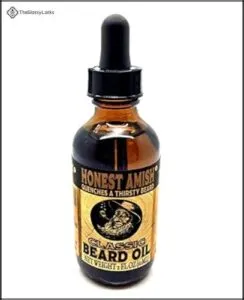
In the area of trusted beard care, Honest Amish Classic Beard Oil stands out as a dermatologist favorite.
This handcrafted formula contains 14 natural oils, including organic virgin argan and golden jojoba, that nourish your facial hair while preventing skin dryness underneath.
You’ll notice softer, more manageable whiskers with a subtle woodsy scent that won’t overpower your cologne.
Made in the USA without synthetic chemicals, it absorbs quickly without leaving greasy residue, making it perfect for daily use with a formula that is a natural oils blend.
Best For: Individuals seeking a natural, chemical-free beard oil to soften facial hair, prevent dryness, and promote healthy beard growth.
- Made with 14 natural and organic oils for nourishment.
- Absorbs quickly without leaving a greasy residue.
- Handcrafted in the USA with environmentally friendly practices.
- Some users may find the scent unpleasant or too waxy.
- Requires consistent use for the best results.
- Not ideal for those allergic to nut-based oils.
2. Jack Black Beard Oil for Men
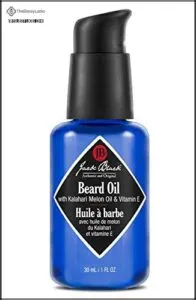
Jack Black Beard Oil combines certified organic oils with potent antioxidants to tackle dry, itchy skin beneath your beard.
You’ll appreciate its fast-absorbing formula featuring Kalahari Melon Oil and Marula Oil, which soften brittle facial hair without leaving greasy residue.
The botanical scent won’t overpower your cologne, making it perfect for daily use.
Customers consistently rate this oil highly for its ability to add healthy shine and control to unruly beards while providing the nourishment your facial hair craves.
Best For: Men looking to soften brittle facial hair, reduce itchiness, and achieve a well-conditioned, healthy-looking beard.
- May not be suitable for those who prefer unscented products.
- Higher price point compared to some other beard oils.
- Requires regular use to see long-term benefits.
- Contains fast-absorbing natural oils like Kalahari Melon Oil and Marula Oil for hydration and softness.
- Free of synthetic fragrance, parabens, and colorants, making it safe for sensitive skin.
- Lightly scented with botanicals, complementing other grooming products.
3. Organic Sandalwood Beard Softening Oil
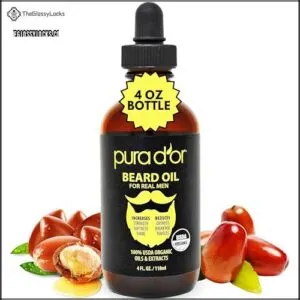
Silky strands become reality with organic sandalwood beard oil’s powerhouse blend of coconut, argan, and jojoba oils.
You’ll notice deeper penetration into hair follicles, delivering essential moisture that transforms coarse, unruly beards into manageable masterpieces.
The lightweight formula absorbs quickly without greasy residue, while real sandalwood essential oil provides that warm, earthy sophistication you’ve been missing.
Rich antioxidants protect against environmental damage, and the precision dropper guarantees you’re getting exact application every time for consistent results.
Best For: Men seeking a natural, non-greasy beard oil that softens coarse beards, hydrates the skin, and provides a warm, earthy sandalwood scent.
- Requires proper dilution of sandalwood oil to avoid skin irritation.
- May not appeal to individuals sensitive to earthy scents.
- Precision dropper could be inconvenient for larger applications.
- Deeply penetrates follicles, moisturizing and softening even the coarsest beards.
- Lightweight, quick-absorbing formula with no greasy residue.
- Natural sandalwood scent adds a sophisticated touch to grooming routines.
4. Aesop Shine Hair and Beard Oil
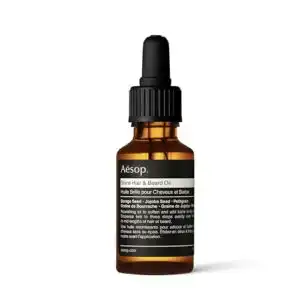
Luxury meets functionality in Aesop’s premium offering that doubles as both hair and beard treatment.
This vegan, silicone-free formula contains borage seed, jojoba seed, and petitgrain oils that deliver essential fatty acids without leaving greasy residue.
You’ll appreciate how it smooths coarse, dry facial hair while adding natural luster.
The green citrus scent provides an upscale grooming experience.
Apply to damp or dry beard, focusing on mid-lengths and ends, for a salon-quality result.
Made with 97% recycled packaging, it’s perfect for environmentally conscious men wanting these results.
Best For: Men with coarse, dry, or frizzy hair and beards looking for a vegan, eco-friendly grooming product with natural shine and nourishment.
- May not suit individuals with fine or oily hair.
- Higher price point compared to basic grooming oils.
- Limited availability to specific retailers or regions.
- Nourishes and softens hair and beard without greasy residue.
- Pleasant green citrus and floral aroma for a refined grooming experience.
- Made with sustainable ingredients and packaging.
5. Anthony Pre Shave Beard Oil
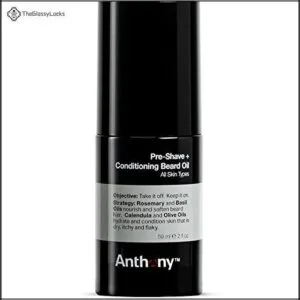
When you’re dealing with stubborn facial hair that fights back during shaving, Anthony Pre-Shave Beard Oil steps up as your dual-purpose ally.
This versatile formula softens scruff before you shave while conditioning your beard hair and underlying skin.
Packed with vitamin E, calendula oil, and energizing rosemary and basil oils, it prevents irritation and tames unruly whiskers.
The lightweight blend works perfectly for all skin types, making it especially valuable for guys with medium to heavy beards who need extra preparation.
Best For: Men with medium to heavy beards looking to soften scruff before shaving and condition their beard and skin.
- Dual-purpose formula softens scruff and conditions.
- Reduces irritation and tames unruly whiskers.
- Suitable for all skin types.
- May not provide enough hydration for very coarse beards.
- Limited availability in physical stores.
- Higher price point compared to basic beard oils.
6. Beardbrand Sandalwood Cedar Beard Oil

The Beardbrand Sandalwood Cedar Beard Oil delivers a premium grooming experience with its woody fragrance featuring teakwood, rosemary, and citrus notes.
You’ll find this 3.4-ounce bottle packed with nourishing oils including grape seed, apricot kernel, sweet almond, castor seed, and golden jojoba.
It effectively hydrates your skin while softening facial hair, making it easier to manage.
This versatile oil doubles as a styling agent, helping you shape your beard while keeping it healthy and well-conditioned throughout the day.
Best For: Men seeking a high-quality beard oil with a woody fragrance that nourishes, hydrates, and styles their beard.
- Contains premium oils like grape seed, apricot kernel, and jojoba for deep hydration.
- Provides a woody, refined fragrance with notes of teakwood, rosemary, and citrus.
- Doubles as a styling agent for easy beard management.
- Fragrance may not appeal to those preferring unscented products.
- No details provided on eco-friendly or sustainable practices.
- Not explicitly stated if suitable for sensitive skin or allergy-prone users.
7. MARLOWE Fragrance Free Beard Oil
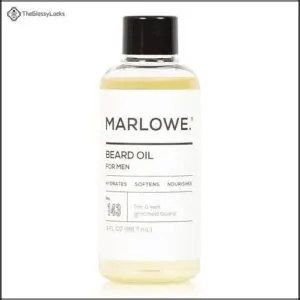
Sensitive skin doesn’t have to mean sacrificing beard health. This fragrance-free formula delivers essential hydration using sunflower and safflower oils, eliminating the guesswork for men with allergies or scent preferences.
You’ll notice softer whiskers and reduced itchiness within days of regular use. The lightweight texture absorbs quickly without leaving greasy residue, making it perfect for daily application.
Made in the USA with globally sourced ingredients, this cruelty-free option proves that effective beard care doesn’t require compromising your values or comfort.
Best For: Men with sensitive skin or fragrance preferences looking for a lightweight, nourishing beard care solution.
- Hydrates and softens beard and skin without greasy residue.
- Fragrance-free and suitable for sensitive skin.
- Made with natural, cruelty-free ingredients.
- May not address beard growth concerns directly.
- Requires regular use for noticeable results.
- Lightweight formula might not suit those with very coarse beards.
8. Honest Amish Fragrance Free Beard Oil
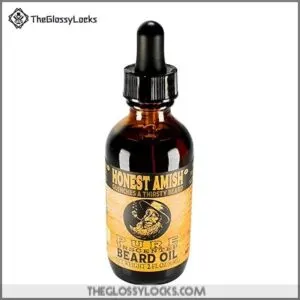
Rounding out our top picks, Honest Amish Fragrance Free Beard Oil delivers exceptional results without breaking the bank.
You’ll appreciate its certified organic formula that moisturizes both your beard and underlying skin. The lightweight, non-greasy texture absorbs quickly, making it perfect for daily use.
With 95% customer satisfaction and zero synthetic fragrances, it’s ideal if you have sensitive skin or fragrance allergies.
This handcrafted American-made oil softens coarse hair while reducing irritation, proving that quality doesn’t require fancy packaging, and is a great choice for those with sensitive skin or fragrance allergies.
Best For: Individuals with sensitive skin or fragrance allergies seeking a high-quality, natural beard oil.
- Made with certified organic ingredients and zero synthetic fragrances.
- Lightweight, non-greasy formula absorbs quickly.
- Handcrafted in the USA with eco-friendly packaging.
- May require a patch test for first-time users.
- Needs cool, dry storage to maintain product integrity.
- Limited availability in larger retail chains due to small batch production.
Natural Ingredients for Beard Growth
You can harness nature’s power to stimulate beard growth through scientifically-backed ingredients that target hair follicles and improve circulation.
These natural compounds, including rosemary oil, caffeine, and biotin, work by nourishing follicles and promoting the cellular processes that encourage thicker, fuller facial hair growth.
Rosemary and Caffeine
Beyond commercial beard oils, specific natural ingredients pack serious punch for facial hair growth.
Rosemary oil delivers proven follicle stimulation through improved circulation boost, while caffeine absorption enhances blood flow to dormant hair roots.
These powerhouse ingredients appear in top-tier beard growth serum formulations that dermatologist recommendation studies support.
Key rosemary benefits and caffeine advantages:
- Enhanced blood circulation – Both ingredients increase nutrient delivery to facial hair follicles
- DHT protection – Rosemary oil blocks harmful hormones that inhibit beard growth naturally
- Faster absorption rates – Caffeine penetrates skin barriers more effectively than many synthetic alternatives
Biotin and Panax Ginseng
Moving beyond topical applications, biotin and panax ginseng root represent powerhouse hair growth supplements with solid clinical evidence.
Biotin benefits include keratin production, while ginseng effects target dermal papilla cells.
Dermatologist recommendation optimization suggests combining these ingredients for supplement synergy.
Here’s what ideal dosage research reveals:
| Ingredient | Daily Dosage | Primary Benefit |
|---|---|---|
| Biotin | 2.5-5mg | Keratin synthesis |
| Panax Ginseng | 200-400mg | Follicle stimulation |
Vitamin B5 and Neoxyl
Vitamin B5 nourishes follicles while thickening hair strands for enhanced beard growth products.
Neoxyl, found in dermatologist recommendation optimization formulas, demonstrates 41% superior efficacy compared to minoxidil through ingredient synergy.
These effective formulas boost absorption rates while remaining gentle on sensitive skin.
B5 benefits include improved circulation, while Neoxyl efficacy stems from ten stimulating compounds working together, showcasing ingredient synergy.
Beard Growth Serums and Tablets
If you’re looking to boost beard growth, serums and tablets might be worth considering.
These products often combine scientifically backed ingredients like Minoxidil or biotin to target hair follicles and promote thicker, fuller facial hair over time.
Neofollics Treatment
Neofollics offers a thorough beard growth serum that stands out among dermatology-recommended products.
This treatment combines Neoxyl efficacy with proven Neofollics ingredients, delivering impressive user satisfaction rates through its structured treatment regimen. You can find the Neofollics beard serum available online.
Key Neofollics Treatment Components:
- Beard Growth Tablets – Essential nutrients that enhance follicle induction
- Specialized Serum – 10 active ingredients for stimulation and skin soothing
- Derma Roller – Creates microscopic channels for better absorption
- 3-4 Month Protocol – Consistent use yields fuller, denser beard growth
Minoxidil Serum
Minoxidil serum stands as dermatology’s gold standard for hair regrowth.
Looking to unlock your beard’s full potential? Minoxidil remains the scientifically-proven champion for transforming patchy facial hair into fuller, thicker growth.
You’ll apply this beard growth serum twice daily to clean, dry facial skin.
Minoxidil effectiveness peaks after 4-6 months of consistent use, though serum side-effects like skin irritation may occur.
Long-term usage requires commitment, but Minoxidil alternatives exist if you experience adverse reactions.
Many users purchase beard growth products online.
| Minoxidil Benefits | Potential Drawbacks |
|---|---|
| Clinically proven hair regrowth | Requires daily application |
| FDA-approved for scalp use | May cause skin irritation |
| Increases follicle activity | Results take 4-6 months |
| Available without prescription | Must continue indefinitely |
| Works on existing follicles | Not effective for everyone |
Derma Roller Therapy
Microneedling with a derma roller creates tiny wounds that kickstart your body’s healing response, boosting collagen production for healthier follicles.
You’ll want a 0.5-1.0mm needle size for beard areas, rolling twice weekly to avoid skin sensitivity.
Most dermatology experts recommend adding this to your skincare routine alongside other beard growth products, with expected results typically appearing after 2-3 months of consistent rolling technique and treatment frequency.
Promoting Facial Hair Growth
You can support your beard’s natural growth potential through simple lifestyle changes that complement topical treatments and products.
Proper nutrition, stress management, and regular exercise work together to optimize your hormone levels and create the best conditions for facial hair development, which can be further enhanced by topical treatments.
Diet and Nutrition
Your diet directly impacts beard growth through proper nutrition.
Protein intake supports hair follicle development, while vitamins like B12, D, and biotin strengthen facial hair.
Minerals including zinc and iron prevent thinning, and healthy fats from nuts and fish nourish follicles.
Hydration keeps hair healthy, and a balanced diet with these supplements creates ideal conditions for robust beard growth, supported by proper nutrition and including key nutrients.
Stress Reduction and Sleep
How well are you sleeping these days? Poor sleep quality and elevated stress hormones like cortisol can seriously derail your beard growth goals.
When you’re constantly stressed, your body prioritizes survival over growing facial hair. Practice relaxation techniques like deep breathing or meditation to support mental health.
Quality rest and effective stress management boost overall wellbeing, creating ideal conditions for robust beard development.
Exercise and Testosterone Boosting
Regular exercise naturally boosts testosterone levels, which directly impacts DHT production and beard growth.
Weight training and high-intensity workouts show the strongest effects on hormone optimization. You’ll see better results with 3-4 weekly sessions focusing on compound movements like squats and deadlifts.
This healthy lifestyle approach complements sleep quality improvements, creating an ideal environment for facial hair development through enhanced testosterone.
Beard Transplant Surgery
If you’re considering a permanent solution for patchy or thin facial hair, beard transplant surgery offers a surgical option that moves hair follicles from your scalp to areas where you want beard growth.
This procedure requires careful evaluation of your donor hair availability, recovery planning, and budget considerations since it’s a significant investment with both surgical risks and permanent results.
Procedure and Risks
When lifestyle changes and minoxidil can’t achieve your beard goals, transplant surgery offers a permanent solution.
This procedure involves extracting hair follicles from your scalp and implanting them into facial areas.
However, surgical complications require careful consideration:
- Transplant rejection – grafts may fail to establish proper blood supply
- Anesthesia risks – potential allergic reactions or breathing difficulties
- Scarring potential – permanent marks at donor and recipient sites
- Infection control – post-surgical complications requiring physician consultation
Dermatologist evaluation confirms you’re a suitable candidate before proceeding.
Recovery Time and Cost
Transplant downtime typically spans 7-14 days, with full recovery taking several months.
Surgery cost ranges from $5,000-$15,000, making it a significant long-term investment compared to beard growth products a dermatologist might recommend.
Hidden costs include follow-up appointments and potential medication expenses.
Many clinics offer financing options to help manage your budget during the recovery time process.
Candidate Selection and Donor Hair
Before considering beard transplant Miami procedures, you’ll need adequate donor area hair density on your scalp or body.
During your beard transplant consultation, surgeons evaluate scalp health and graft quality to determine if you’re a suitable candidate.
Hair follicles transfer requires realistic transplant expectations about coverage and growth patterns.
Not everyone qualifies for beard restoration options due to insufficient donor hair availability.
Maintaining a Healthy Beard
You’ve successfully grown your beard, but keeping it healthy requires consistent care and proper grooming techniques.
Regular trimming, quality oil application, and structured maintenance routines guarantee your facial hair stays strong, manageable, and continues growing at its peak rate, ensuring it remains healthy.
Beard Care and Grooming
Once you’ve invested in beard growth treatments, proper beard care routine becomes your daily foundation.
Beard washing twice weekly prevents buildup while daily beard oil application keeps follicles healthy.
Quality grooming tools like boar bristle combs distribute natural oils evenly. Beard balms provide styling techniques for unruly hairs.
These beard grooming tips maximize your growth investment results.
Trimming and Shaping
Regular trimming shapes your beard and prevents split ends that slow growth.
Use quality trimming tools like sharp scissors and adjustable clippers. Start with longer settings and work down gradually.
Follow your natural jawline when shaping techniques matter most. A good beard comb helps guide your trim.
Schedule maintenance every two weeks, or visit a professional barber monthly for complex beard styles.
Beard Oil and Balm Application
After perfecting your beard’s shape, proper beard oil and balm application becomes your daily ritual. Start with oil on damp facial hair, then layer balm for hold and styling.
Application frequency matters—use oil twice daily, balm once. Oil absorption takes minutes, while balm provides lasting structure for beard care routines. To effectively use beard oil, make certain of even distribution.
- Warm three drops of beard oil between your palms before massaging into damp whiskers
- Apply balm by scraping a small amount with your thumbnail, then working it through completely
- Layer products strategically—oil first for nourishment, balm second for styling and control
- Massage oil deep into your skin to prevent itchiness and promote healthy follicle growth
- Use a boar bristle brush after application to distribute beard products evenly throughout your facial hair
Maximizing Beard Growth Potential
You can achieve your best beard growth results by combining proven medical treatments with natural ingredients that support follicle health.
This strategic approach maximizes your genetic potential while addressing multiple factors that influence facial hair development, from hormone optimization to targeted nutrition.
Combining Medical and Natural Treatments
Smart beard enthusiasts combine minoxidil with rosemary oil for synergistic beard therapies that amplify results.
Integrated treatment plans pair dermatology optimization with natural supplement pairings like biotin and vitamin D.
This holistic beard growth approach maximizes effective ingredients while minimizing side effects.
Your beard growth serum works better when supported by proper nutrition and stress management techniques, and using natural supplement pairings can enhance overall effectiveness.
Ongoing Research and Developments
While current treatments show promise, researchers are exploring exciting future therapies including stem cells and novel ingredients targeting hair growth molecules.
Genetic research into DHT blockers could revolutionize beard growth effectiveness.
Clinical studies on beard growth serum ingredients continue advancing, with scientists investigating new molecular pathways.
These developments may soon offer more powerful, personalized solutions for facial hair enhancement.
Frequently Asked Questions (FAQs)
What can a dermatologist do for beard growth?
Like a gardener tending barren soil, your dermatologist can prescribe minoxidil, diagnose underlying conditions affecting growth, recommend hormone therapy if needed, and discuss beard transplant options for permanent results.
What is the 3 month beard rule?
The 3-month beard rule suggests giving your facial hair a full 90 days to grow before making major styling decisions.
You’ll see your beard’s true potential and growth patterns after this patience-testing period, which can help you make informed decisions about your beard.
Does anything actually help beard growth?
Think of your beard like a garden – some seeds need extra help to flourish.
Yes, minoxidil actually works by stimulating follicles.
Testosterone therapy helps transgender men.
Genetics still rule, but science offers real solutions.
What is the rule 5 for beards?
Rule 5" isn’t a standard beard grooming guideline. You might be thinking of the "five o’clock shadow" or specific beard length measurements. Could you clarify what beard rule you’re referencing?
Can diet supplements accelerate beard growth timeline?
Only 3% of men see significant beard growth from supplements alone.
You can’t shortcut genetics with pills, but biotin and vitamin D might support existing follicles.
Real acceleration comes from patience, not promises.
Do beard growth vitamins actually work effectively?
Beard growth vitamins show mixed results.
Biotin and vitamin D may support hair health, but they won’t magically transform patchy beards.
Your genetics and hormones matter more than supplements for actual growth.
How long before seeing noticeable beard improvements?
Like watching grass grow, patience becomes your best friend when growing facial hair. You’ll typically notice initial changes within 2-4 weeks, but significant improvements take 2-3 months of consistent care.
Are there any serious side effects risks?
Most beard growth products carry minimal risks, but minoxidil can cause skin irritation, dizziness, or rapid weight gain.
Finasteride may reduce libido or cause fertility issues.
Always consult your dermatologist before starting treatments.
Can women safely use beard growth products?
Surprisingly, most beard growth products aren’t designed for women’s facial hair needs.
You’ll want dermatologist guidance since hormonal differences affect hair growth patterns.
Products containing minoxidil may cause unwanted facial hair elsewhere.
Conclusion
Growing a fuller beard is like tending a garden—you’ll need the right tools and patience to see results.
Beard growth products dermatologist recommended combine proven science with practical application. Minoxidil remains the gold standard for stimulating follicles, while quality oils containing rosemary and biotin support natural growth processes.
You’ll achieve the best outcomes by combining medical treatments with consistent grooming habits. Remember, genetics set your limits, but the right products help you reach your maximum potential safely and effectively.
- http://pubmed.ncbi.nlm.nih.gov/26893270/?utm_source=mdacne_blog&utm_medium=mdacne_blog&utm_campaign=thicker-beard-best-serums
- https://medlineplus.gov/ency/article/003707.htm
- https://derm.uw.edu/faculty/jay-vary-md-phd
- https://www.healthline.com/health/excessive-or-unwanted-hair-in-women
- https://gillette.com/en-us/shaving-tips/how-to-shave/beard-growth-science

